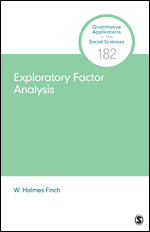Exploratory Factor Analysis
- W. Holmes Finch - Ball State University, USA
Intermediate/Advanced Statistics | Quantitative Methods | Quantitative Research Methods in Education | Quantitative Research Methods in Education | Statistics - General Interest | Statistics in Criminal Justice | Statistics in Political Science | Statistics in Psychology | Statistics in Sociology
This text is a perfect resource for individuals seeking guidance on applied factor analysis, covering the fundamentals as well as introductions to more advanced aspects of factor analytic techniques.
Finch provides a well-written and well-organized introduction to the conceptual and quantitative topics of exploratory and confirmatory factor analysis within a single, concise text.
This is a thorough and readable introduction to exploratory factor analysis

 Sage College Publishing
Sage College Publishing

